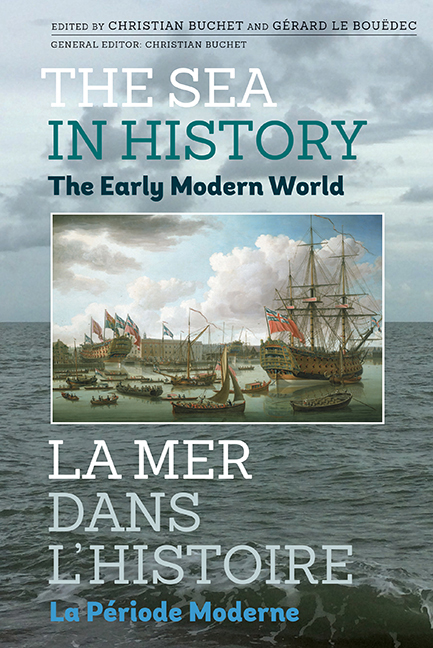Book contents
- Frontmatter
- Contents
- List of Illustrations
- List of Contributors
- Introduction générale et remerciements par
- General introduction and acknowledgements
- Introduction (français)
- Introduction (English)
- LA RÉUSSITE PAR LA MER:La reussite par la mer des territoires et des communautés littorales
- La construction d'un espace mondial: La circulation maritime et les ports
- Les dynamiques des circulations maritimes au XVIIIe siècle entre paix et guerre: ports, circuits, flottes entre logiques étatiques et logiques marchandes
- The European seaport system at the beginning of the early modern age
- Port location and development in the British Atlantic World in the seventeenth and eighteenth centuries
- Mutations et recompositions des flottes marchandes en Méditerranée
- Indian ports and European powers
- African Atlantic ports and trade fleets
- Les ports du Maghreb à l'époque moderne
- La forte croissance de l'économie des pêches et des échanges
- Les acteurs de la dynamique maritime
- LA PUISSANCE MARITIME INSTRUMENT DE LA PUISSANCE POLITIQUE ET D'UNE STRATÉGIE GLOBALE DE RAYONNEMENT VOIRE DE DOMINATION: Les puissances maritimes occidentales
- L'océan Indien, entre convoitises et indifférences
- Les puissances maritimes asiatiques
- L'Afrique
- La politique maritime et l'idéologie
- Mer et développement technologique
- Développement maritime et maîtrise économique et financière
- Développement maritime et maîtrise organisationnelle
- Conclusion (français)
- Conclusion (English)
- Conclusion générale par
- General conclusion by
- Miscellaneous Endmatter
- Miscellaneous Endmatter
Les ports du Maghreb à l'époque moderne
from La construction d'un espace mondial: La circulation maritime et les ports
Published online by Cambridge University Press: 11 May 2017
- Frontmatter
- Contents
- List of Illustrations
- List of Contributors
- Introduction générale et remerciements par
- General introduction and acknowledgements
- Introduction (français)
- Introduction (English)
- LA RÉUSSITE PAR LA MER:La reussite par la mer des territoires et des communautés littorales
- La construction d'un espace mondial: La circulation maritime et les ports
- Les dynamiques des circulations maritimes au XVIIIe siècle entre paix et guerre: ports, circuits, flottes entre logiques étatiques et logiques marchandes
- The European seaport system at the beginning of the early modern age
- Port location and development in the British Atlantic World in the seventeenth and eighteenth centuries
- Mutations et recompositions des flottes marchandes en Méditerranée
- Indian ports and European powers
- African Atlantic ports and trade fleets
- Les ports du Maghreb à l'époque moderne
- La forte croissance de l'économie des pêches et des échanges
- Les acteurs de la dynamique maritime
- LA PUISSANCE MARITIME INSTRUMENT DE LA PUISSANCE POLITIQUE ET D'UNE STRATÉGIE GLOBALE DE RAYONNEMENT VOIRE DE DOMINATION: Les puissances maritimes occidentales
- L'océan Indien, entre convoitises et indifférences
- Les puissances maritimes asiatiques
- L'Afrique
- La politique maritime et l'idéologie
- Mer et développement technologique
- Développement maritime et maîtrise économique et financière
- Développement maritime et maîtrise organisationnelle
- Conclusion (français)
- Conclusion (English)
- Conclusion générale par
- General conclusion by
- Miscellaneous Endmatter
- Miscellaneous Endmatter
Summary
RÉSUMÉ. Depuis Agadir jusqu'à Tripoli, de nombreux havres autorisaient l'accostage mais seuls les ports de Tétouan, Oran, Alger et Tunis furent aménagés. Les capitales (ou les ports qui leur servaient d'ouverture maritime) et les havres spécialisés dans la traite des blés prirent de l'importance. Avec le développement de la demande européenne en céréales et l'installation de compagnies à concessions dans le Constantinois et le nord-ouest tunisien, le trafic de havres tels que La Calle, Collo, Bastion de France, Tabarka et cap Nègre, augmente dans des proportions spectaculaires, dès le début du XVIIe siècle. Course et commerce font souvent bon ménage dans les ports maghrébins. Dans la deuxième moitié du XVIIIe siècle, le caractère corsaire dominant dans les ports maghrébins s'efface au profit du commerce. Seuls deux ports bénéficièrent de grands aménagements à la fin du XVIIIe siècle, Essaouira au Maroc et le nouveau port de Tunis-La Goulette.
ABSTRACT. From Agadir to Tripoli, many harbours authorized vessels to dock, but the only wellequipped ports were Tetouan, Oran, Algers, and Tunis. The capital cities (or the ports which served them as a maritime opening) and the harbours specialized in trading wheat gained importance. As a result of Europe's increased demand for cereals and the establishment of concession companies in the Constantinois and northwestern Tunisia, the traffic of harbours such as La Calle, Collo, Bastion de France, Tabarka and Cap Nègre increased in spectacular proportions from the start of the 17th century. Maritime race and commerce made a good pair in the Maghreb ports. In the second half of the 18th century, the dominant corsair character in the Maghreb ports disappeared in favor of trade. Only two ports benefited from great infrastructural works at the end of the 18th century: Essaouira in Morocco and the new port of Tunis-La Goulette.
L'ouverture maritime du Maghreb est une constante de son histoire, de l'Antiquité à nos jours. Les puniques firent vivre la région sur le modèle d'un empire de comptoirs. Les romains concentrèrent l'activité maritime sur quelques ports, notamment Carthage. Les musulmans, quant à eux, dont l'empire englobait au Moyen Âge l'Andalousie et la Sicile, accrurent le rôle de transit de leurs ports vers l'Europe, en relation avec le commerce saharien.
- Type
- Chapter
- Information
- The Sea in History - The Early Modern World , pp. 199 - 210Publisher: Boydell & BrewerPrint publication year: 2017



